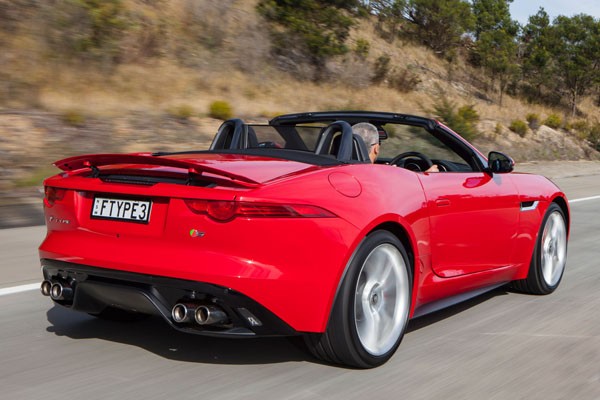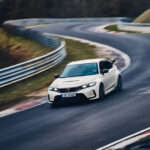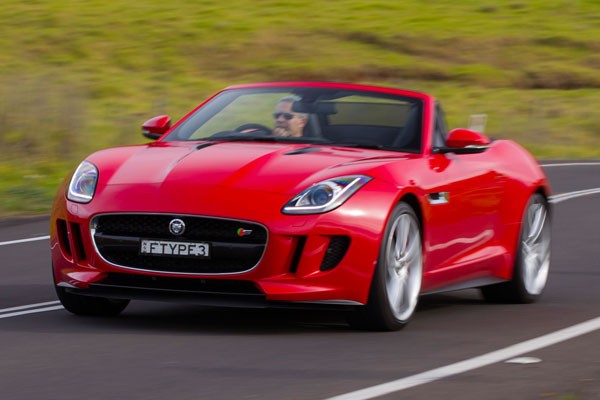
Jaguar’s E-Type is arguably one of the most visually distinctive of all classic sportscars. Introduced in the UK in 1951 it continued in production for almost 15 years, seemingly getting better with each new iteration.
Though the iconic British marque has since sold XK models in the intervening years most purists regard these as grand tourers rather than sportscars. Therefore the Jaguar F-Type convertible, which reached us downunder in August 2013, is argued by many as being the true replacement for the E-Type.
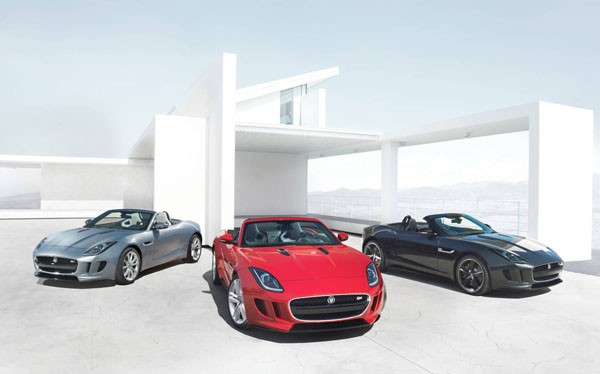 STYLING
STYLING
We love the shape of the Jaguar that we reluctantly handed back yesterday. Reminiscing over the E-Type soon became a regular part of our day as enthusiasts stopped us to talk about the F-Type just about every time we pulled up.
There’s general agreement that the front, with its large ‘mouth’, ultra-long bonnet, centre bulge and cooling ducts could have come from the pen of Sir William Lyons, the genius who designed the Jaguar E-Type all those years ago.
The rear tends to take its own direction in style with the relatively tall tail tapering slightly forward as it descends. It looks like nothing else in this class of sportscar – and we like it even more because of that.
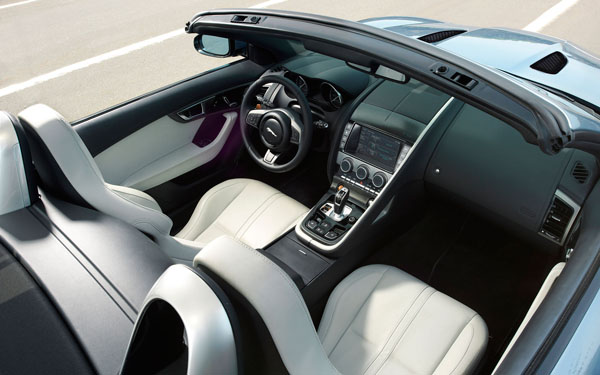
Inside, the twin round dials immediately in front of the driver give it a classic sporting appearance. The centre console is surprisingly wide for a car of this size, but it does work nicely.
Not visible under these superb lines is the fact that the F-Type is made almost exclusively from aluminium. This lightweight material isn’t easy to work with, but the guys and gals at Jaguar have done a superb job.
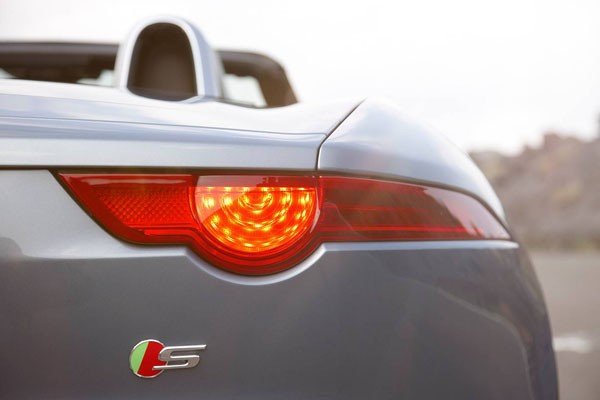 ENGINES / TRANSMISSIONS
ENGINES / TRANSMISSIONS
Our test Jaguar F-Type was the midrange 3.0-litre V6 supercharged S version, the one that’s proving to be the most popular on the sales floor. With outputs of 280 kilowatts of power it sits neatly between the standard (if any Jaguar can be considered to be merely standard) which has the 3.0-litre supercharged V6 in a lower state of tune to put out 250 kilowatts, and the redhot F-Type V8 S with a huge 364 kW from its, again supercharged, 5.0 litres.
SAFETY
This Jaguar sailed with ease through crash testing to gain five stars. As well as the passive safety proven by this brutal testing this sports machine has magnificent dynamics and huge brakes.
 DRIVING
DRIVING
The front seats nestled against my backside nicely, but someone who is wider than average in the posterior may find them less comfortable. The leather trim on the seats was firmer than I like, but, obviously, try for yourself.
This is strictly a two seater, indeed there’s a minimum of space behind the seats and tall occupants who want to lean their seats back may find themselves wishing for more room. Then again, that’s not uncommon in this class.
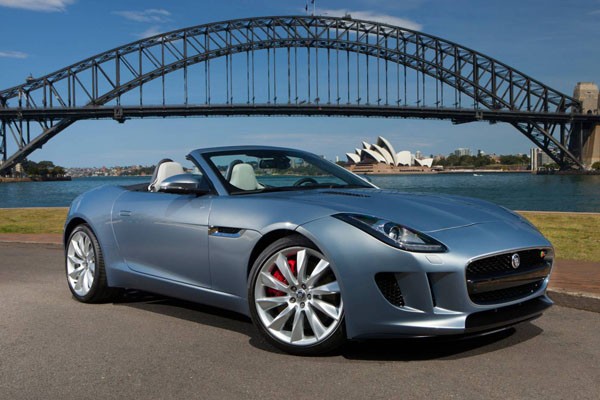 The door pockets are a good size and there’s further stowage space between the seat backs.
The door pockets are a good size and there’s further stowage space between the seat backs.
Driving is what this full-on sports Jaguar is all about. And we loved our too-short week behind the wheel. The engines sound is just right and there were plenty of occasions when we had to check the Jaguar’s roar was coming from six cylinders and not eight. That’s due to the slightly uneven beat that’s so typical of a good V8.
The push in the back when you really get stuck into the throttle begins virtually instantaneously – a real advantage of a supercharger over a turbocharger. The torque is provided in a beautifully linear manner and keep coming and coming.
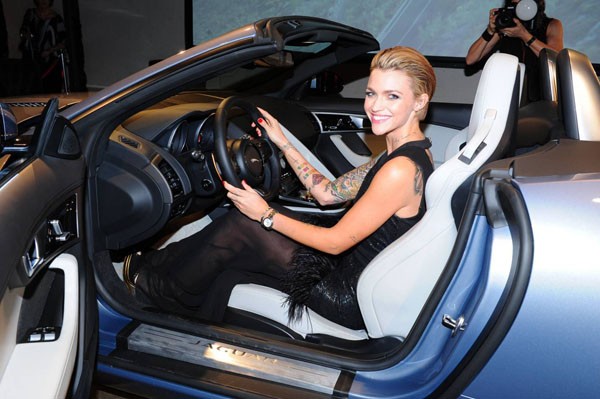 Handling is sharp and precise and the little Jag ‘talks’ to you responsively through the steering wheel and the seat of your pants. There’s an immense amount of grip and the balance in the, relatively, lightweight chassis gives it a much nimbler feel than you might anticipate.
Handling is sharp and precise and the little Jag ‘talks’ to you responsively through the steering wheel and the seat of your pants. There’s an immense amount of grip and the balance in the, relatively, lightweight chassis gives it a much nimbler feel than you might anticipate.
Aluminium is also used in the suspension components, further adding to the nimble feeling provided.
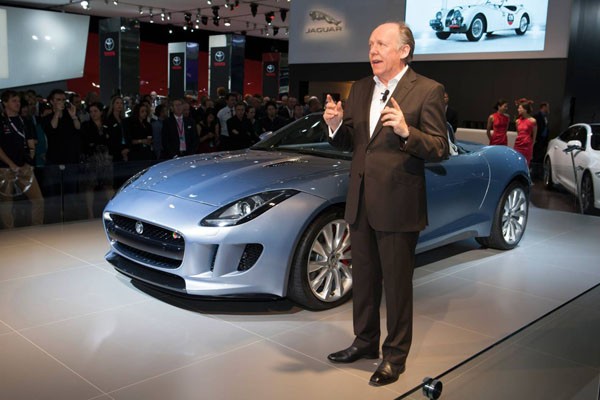 SUMMING UP
SUMMING UP
It’s been a long time coming but the all-new Jaguar F-Type is something special and with a price that ranges from just $138,645 it will challenge roadster models from BMW, Mercedes-Benz and in particular Porsche.
The Jaguar F-Type’s recommended price includes free scheduled servicing for three years or 100,000 km, whichever comes first.
Jaguar took the unusual step of introducing the F-Type convertible before the coupe version – normally it’s the other way around. The coupe has been introduced in the UK and will soon make its way down to Australia as well. We can’t wait for the excuse to borrow one for another week’s road review.
AT A GLANCE
MODEL RANGE
F-Type 3.0-litre V6 supercharged petrol two-door convertible: $138,645 (automatic)
F-Type S 3.0-litre V6 supercharged petrol two-door convertible: $171,045 (automatic)
F-Type V8 S 5.0-litre supercharged petrol two-door convertible: $219,600 (automatic)
Note: These prices do not include government or dealer delivery charges. Contact your local Jaguar dealer for drive-away prices.
FEATURES
ABS Brakes: Standard in all models
Automatic Transmission: Standard in all models
Cruise Control: Standard in all models
Dual Front Airbags: Standard in all models
Front Side Airbags: Standard in all models
Electronic Stability Program: Standard in all models
Rear Parking Sensors: Standard in all models
Reversing Camera: Optional in all models
USB/Auxiliary Audio Inputs: Standard in all models
Bluetooth: Standard in all models (telephone and audio streaming)
Steering Wheel Mounted Controls: Standard in all models
SPECIFICATIONS (Jaguar F-Type S 3.0-litre supercharged petrol two-door convertible)
ENGINE:
Capacity: 2.995 litres
Configuration: Transverse, four cylinders in line
Head Design: V6
Compression Ratio: 10.5:1
Bore/Stroke: 84.5 mm x 89.0 mm
Maximum Power: 280 kW @ 6500 rpm
Maximum Torque: 450 Nm @ 3500-4500 rpm
DRIVELINE:
Driven Wheels: Rear
Manual Transmission: Not offered
Automatic Transmission: Eight-speed
Final Drive Ratio: Not supplied
DIMENSIONS, WEIGHT AND CAPACITIES:
Length: 4470 mm
Wheelbase: 2622 mm
Width: 2042 mm
Height: 1308 mm
Turning Circle: 10.7 metres
Kerb Mass: 1614 kg
Fuel Tank Capacity: 70 litres
Towing Ability: Not recommended for towing
Boot Capacity: 148 litres
PERFORMANCE:
0-100 km/h Acceleration: 4.9 seconds
FUEL CONSUMPTION:
Type: Petrol 95RON
Combined Cycle (ADR 81/02): 9.1 L/100km
GREEN VEHICLE GUIDE RATINGS:
Greenhouse Rating: 6/10
Air Pollution Rating: 7.5/10
STANDARD WARRANTY
Three years/100,000 km




